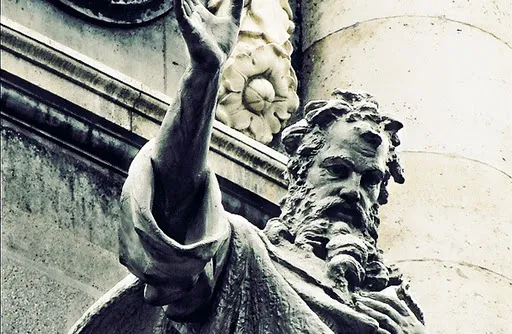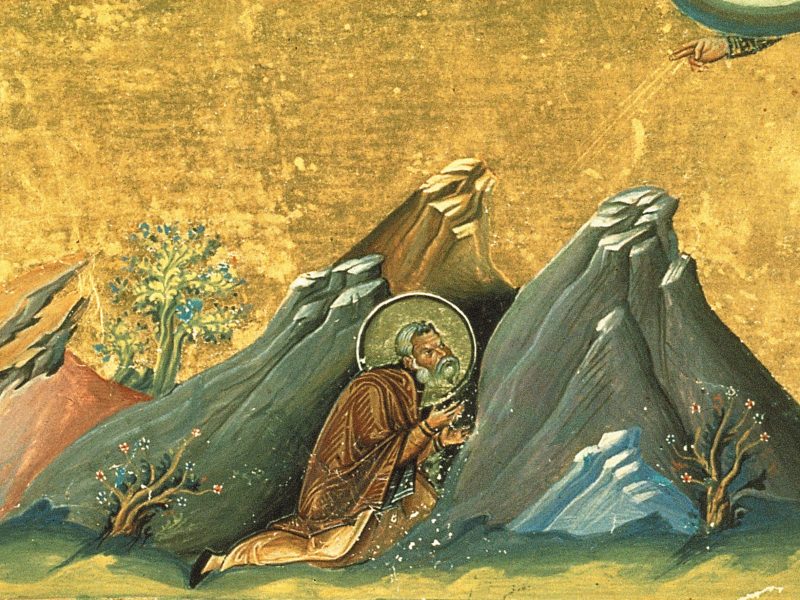by Gideon Lazar
This is the second in a series of articles on Genesis as a polemic. Part 1 can be found here and part 3 can be found here.
In part one, we discussed how Genesis in its original context was a polemic against false pagan teachings about creation. It was not a polemic in the sense of just being a direct condemnation, but rather it worked as a condemnation by unveiling the true order of creation. Genesis serves a wellspring of true teaching about creation.
As a source of enduring truth on creation, it serves not just a polemic in its original context but can be used as a source against new errors as they arise. This was already the case by the second century when St. Irenaeus, the bishop of Lyons and the most recently named Doctor of the Church, used Genesis to craft his polemic against Gnosticism.
Gnosticism was a group of heresies that plagued the early Church. Seeking a synthesis of paganism and Christianity, the Gnostics claimed that the god who made this world is not the true god. Rather, he is just a demiurge like in Plato’s Timaeus, a lesser spiritual being who shapes the world out of preexistent matter. In many versions of Gnosticism, this demiurge is actively evil, and is identified both with God in the Old Testament and the devil in the New Testament. Jesus however was from the supreme, purely spiritual God and came to rescue humanity from the physical bodies they were trapped inside by the demiurge.

The Gnostics were very influenced by the cosmology of Platonism
Irenaeus recognized that the Gnostic twisting of creation was the root of their heresy, and therefore reclaiming a Christian vision of creation was necessary to refute them. He spends much of the first two books of Against Heresies laying out the errors of the Gnostics. He can only refute an error once he has laid it out, and the heresies of the Gnostics are so absurd that just explaining them is almost a refutation in itself.
In Against Heresies I.18, he looks at how they interpret the books of scripture. For the Gnostics, Genesis contains esoteric numerology which points to their cosmology. [1] The different numbers of things created and days things are created point to different sets of spiritual beings. For example, four things being named in Genesis 1:1 symbolizes the emanation of the “Tetrad,” ten things being created on the first three days symbolizes the emanation of the “Decad,” and the fact that man was created with two ears, two eyes, and two types of taste symbolizes the emanation of the “Ogdoad.” For the Gnostics, Genesis is not an authoritative source handed down from the tradition to help teach the faithful in the Church. Rather, it is a source to be exploited to justify a pagan cosmology.
The Gnostic misuse of scripture is also reflected in their anthropology. For example, in The Secret Book of John, the Gnostic author rewrites the story of Genesis. [2] The God of the Old Testament is renamed as Yaldabaoth. He traps divine light into matter through the creation of man. The physical body then is an evil thing which man seeks to escape. After creating Eve, Yaldabaoth forcibly has children with her, creating Cain and Abel. Sexual procreation therefore is also evil, something placed in man by Yaldabaoth. In contrast, Seth, the good child, is created through pure mental contemplation, not through ordinary means. While the Church has certainly always held celibacy as a higher calling, it has also declared sexual reproduction to be good within its proper context.
Since The Secret Book of John declares God to actually be Satan, it is no surprise that it says that Satan is actually God. The serpent is implied to be Christ who gives Adam and Eve the fruit of the tree so that they can return to their divine state and escape matter. Thus, the entire Biblical story is inverted. The work frequently quotes Genesis in order to make clear that it is retelling the story. However, it views Genesis even more negatively than the Gnostics Irenaeus dealt with in the above quote. It views Genesis as demonic propaganda. Thus, at times the author says that “it did not happen the way Moses said it did.”

The 1945 discovery of the Nag Hammadi Codices vindicated the explanation of Gnosticism given by St. Irenaeus
Irenaeus responds to all of this by going back to Genesis and showing what it actually says. He first starts off by proving that the New Testament affirms the teaching of the Old Testament. [3] If all the apostles affirm and Our Lord Himself affirm the teachings of the Old Testament, it cannot be simply rejected. He also appeals to tradition and the authority of the Church to teach on these matters, most especially the bishop of Rome. [4]
Irenaeus responds more deeply through the use of the typological sense of scripture. He sets passages from one part of scripture together with another to show the continuity of the authorship of scripture. [5] For example, when dealing with original sin, he says that,
For as by one man’s disobedience sin entered, and death obtained [a place] through sin; so also by the obedience of one man, righteousness having been introduced, shall cause life to fructify in those persons who in times past were dead. (Rom 5:19) And as the protoplast himself Adam, had his substance from untilled and as yet virgin soil (for God had not yet sent rain, and man had not tilled the ground (Gen 2:5)), and was formed by the hand of God, that is, by the Word of God, for all things were made by Him, (John 1:3) and the Lord took dust from the earth and formed man; so did He who is the Word, recapitulating Adam in Himself, rightly receive a birth, enabling Him to gather up Adam [into Himself], from Mary, who was as yet a virgin. If, then, the first Adam had a man for his father, and was born of human seed, it were reasonable to say that the second Adam was begotten of Joseph. But if the former was taken from the dust, and God was his Maker, it was incumbent that the latter also, making a recapitulation in Himself, should be formed as man by God, to have an analogy with the former as respects His origin. Why, then, did not God again take dust, but wrought so that the formation should be made of Mary? It was that there might not be another formation called into being, nor any other which should [require to] be saved, but that the very same formation should be summed up [in Christ as had existed in Adam], the analogy having been preserved. [6]
Here, he uses the New Testament to illuminate the Old and vice versa. Romans clarifies that Genesis means that Adam really did introduce death into the word. Likewise, this sin illuminates the New Testament by explaining the reason for the coming of Christ. He justifies such a reading on the basis that “Adam himself [was] termed by Paul the figure of Him that was to come (Rom 5:14).” [7] Typology is something which Irenaeus learns to do from the methods of apostolic exegesis. His use of typology is not wild speculation as is the numerology of the Gnostics but is rooted in the methods and teachings of the apostles. This is not to say he is limited to only those types that St. Paul drew. He uses typology for example in these chapters to justify the Church’s teachings on Our Lady. However, even this is rooted within intertextual allusion and the apostolic tradition, not secret knowledge or pagan cosmologies.
His use of Genesis is not merely typological though. He also takes it historically. For example, he says that,
Luke points out that the pedigree which traces the generation of our Lord back to Adam contains seventy-two generations, connecting the end with the beginning, and implying that it is He who has summed up in Himself all nations dispersed from Adam downwards, and all languages and generations of men, together with Adam himself. [8]
All the nations come forth from Adam over the course of 72 generations and are then brought back together in Christ. This requires narrative development over time. Irenaeus explains that at his creation “man could not receive this [perfection], being as yet a [spiritual] infant. And for this cause our Lord in these last times, when He had summed up all things into Himself, came to us, not as He might have come, but as we were capable of beholding Him.” [9] God wished man to develop and grow into maturity so that in the fullness of time, Christ would come. Thus, Genesis and the New Testament are connected not only typologically, but also historically. In many Gnostic accounts, everything ends in the oneness in which it began. However, Irenaeus shows that the scriptures teach a historical development from creation into the eschaton.

Irenaeus’s critique of Gnosticism is frequently identified as a metaphysics of recapitulation. [10] Christ is the last Adam who comes and undoes the sin of the first Adam. This is tied to a metaphysics of growth and development, where the first Adam was a spiritual infant and salvation history is a movement towards maturity. Both of these are certainly present in Irenaeus. This metaphysical account would later be developed throughout the tradition. However, Irenaeus’s metaphysics are rooted within his exegesis of scripture. Irenaeus uses the typological sense to develop his metaphysics of recapitulation, and the historical sense to justify his metaphysics of development. In addition, as we have seen, these are also closely tied together because it is a recapitulation into something greater. These important principles of metaphysics, expounded further by later fathers and doctors, have their source in Genesis. For example, St. Maximus utilized this metaphysics to respond to Origenism, another heresy which had its roots in Gnosticism. [11] Irenaeus also takes back the importance of the image of God and the goodness of the body by showing how the same God who created us is also the supreme God.
The enemies of God always work by poisoning the truth. As we saw in part one, pagan creation myths distorted the true creation. God’s revelation at Mount Sinai confounded the pagans and put to rest their superstitions as Moses saw and wrote down the true account of creation. In order to destroy the Church therefore, the enemies of God twisted the meaning of Genesis in the early Church to suit their Platonic theology. Irenaeus therefore returns to Moses’s revelation in order to show what actually happened. He also demonstrates the importance of the teachings of the apostles. Only once Christ has come does the true meaning of scripture come to light. We can discover this truth in the teaching of the apostles through the New Testament, the tradition, and the authority of the bishops, most especially the Pope of Rome.
The work of Irenaeus for the most part served to destroy Gnosticism. However, small elements of it remained for centuries, although always swiftly refuted by the Church. In the next part though, we will look at how a new heretical reading of Genesis cropped up in early modern liberalism to justify its destruction of Christendom, and how the Church has responded to this crisis.
Notes
[1] Irenaeus, Against Heresies, in Ante-Nicene Fathers, vol. 1, trans. Alexander Roberts and William Rambaut, ed. Alexander Roberts, James Donaldson, and A. Cleveland Coxe, (Buffalo, NY: Christian Literature Publishing Co., 1885.), 1.18.
[2] The Secret Book of John is a Gnostic work that was rediscovered in the 20th century among the Nag Hammadi Codices. Irenaeus addresses the Sethian Gnostics who authored this work in 1.30, but since the original work has now been found I have chosen to draw directly from it. The Secret Book of John (The Apocryphon of John), trans. Stevan Davis, The Gnostic Society Library, 2005. http://gnosis.org/naghamm/apocjn-davies.html.
[3] Irenaeus, 3.9-12.
[4] Irenaeus, 3.2-3.
[5] For a detailed study of this issue, see Stephen O. Presley, The Intertextual Reception of Genesis 1-3 in Irenaeus of Lyons, (Leiden: Brill, 2015).
[6] Irenaeus, 3.21.10.
[7] Irenaeus 3.22.3.
[8] Irenaeus 3.22.3.
[9] Irenaeus, 4.38.1.
[10] Thomas Holsinger-Friesen, Irenaeus and Genesis: A Study of Competition in Early Christian Hermeneutics, (Winona Lake: Eisenbrauns, 2009), 1-41.
[11] Gideon Lazar, “St. Maximus’s Metaphysics of Creation in Ambiguum 7,” Creation Theology Fellowship, 2022. https://creationtheologyfellowship.org/2022/07/06/st-maximuss-metaphysics-of-creation-in-ambiguum-7/.


